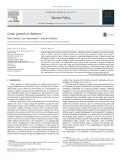This paper uses a Directional Distance Function (DDF) and the Malmquist–Luenberger Productivity Index to estimate the changing patterns of ‘green’ total factor productivity (GTFP) growth of 38 Chinese industrial sectors during the period 1980–2010. Unlike the measures of traditional total factor productivity (TFP) growth, the DDF incorporates carbon dioxide emissions as an undesirable output directly into the production technology, which credit sectors for simultaneously reducing their emissions and increasing their output. Our estimates of aggregate and sector-level GTFP growth reveal that Chinese industry is not yet on the path towards sustainable, low-carbon growth. A dynamic panel data analysis of the determinants of GTFP across sectors is used to identify factors that might rectify this situation, including state owned enterprise (SOE) reform, the growth of small private enterprises, continued openness to foreign investment and higher spending on R&D, particularly in emission-intensive sectors.

This analysis of the emergence since 2008 of the green economy agenda and the related idea of ‘green growth’ focusses upon the articulation of these discourses within key international economic and environmental institutions and evaluates whether this implies the beginning of an institutional transformation towards an ecologically sustainable world economy. The green economy may have the capacity to help animate a transition away from current socially and ecologically unsustainable patterns of economic growth only if notions of green growth can be discursively separated from green economy, strong articulations of green economy become dominant, and alternative measures of progress to gross domestic product are widely adopted. The concept of ‘rearticulation’, found in post-structural discourse theory, is proposed to guide this transition. This offers a framework to reconstruct notions of prosperity, progress, and security whilst avoiding direct and disempowering discursive conflict with currently hegemonic pro-growth discourses.
The paper evaluates the impacts on investments and public finance of a transition to a green, low carbon, economy induced by carbon taxation. Four global tax scenarios are examined using the integrated assessment model WITCH. Taxes are levied on all greenhouse gases (GHGs) and lead to global GHG concentrations equal to 680, 560, 500 and 460 ppm CO2-eq in 2100. Investments in the power sector increase with respect to the Reference scenario only with the two highest taxes. Investments in energy-related R&D increase in all tax scenarios, but they are a small fraction of GDP. Investments in oil upstream decline in all scenarios. As a result, total investments decline with respect to the Reference scenario. Carbon tax revenues are high in absolute terms and as share of GDP. With high carbon taxes, tax revenues follow a “carbon Laffer” curve. The model assumes that tax revenues are flawlessly recycled lump-sum into the economy. In all scenarios, the power sector becomes a net recipient of subsidies to support the absorption of GHGs.
The United States, Europe, and non-governmental international organizations are seeking to encourage the creation of green jobs and the use of non-hydropower renewable energy. This paper discusses the challenge in defining green jobs and reviews definitions across different countries, states, and NGOs. The paper describes some of the costs the United States has faced in creating jobs through programs funded by the Departments of Labor and Energy. The paper concludes by comparing the experiences of China and the United States in the use of renewable energy.
This article appeared in the Energy Economics Supplemental Issue: Green Perspectives.
